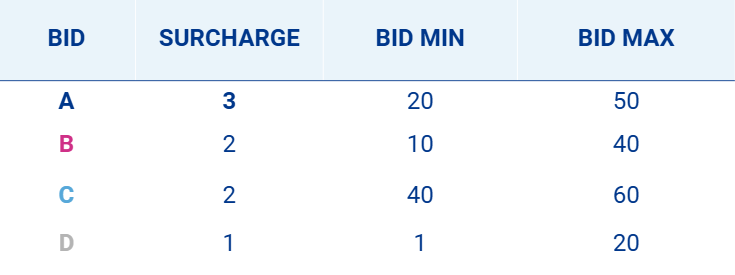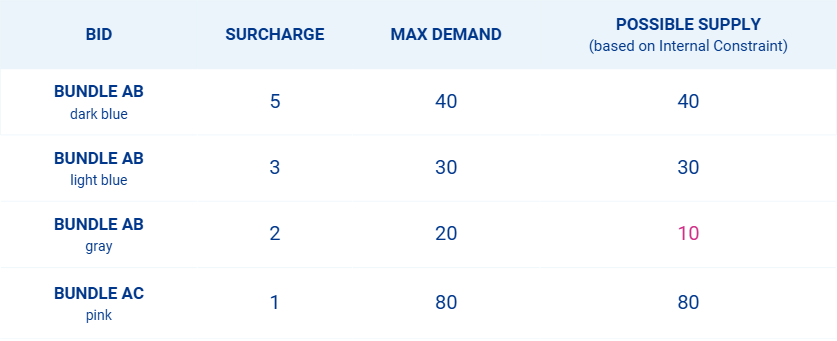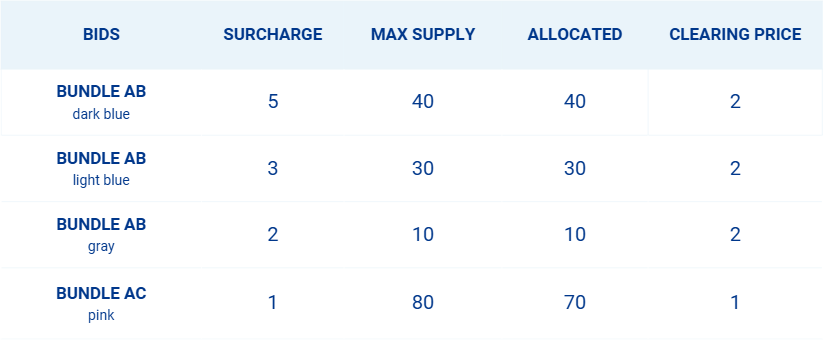Table of contents
Introduction
The uniform price algorithm is used for all short-term auctions (day-ahead and within-day). Through this mechanism, the allocation and price of capacity are determined in an open competition among shippers in one bidding round. Shippers can place bids with a maximum and minimum amount of capacity and the surcharge they are willing to pay. If the sum of all maximum amounts of capacity requested by shippers exceeds the available amount, capacity is allocated giving priority to the shipper(s) who offered the highest surcharge.
General Rules
a. Shippers can place a maximum of ten bids in one bidding round.
b. In their bids, shippers must set a (1) maximum amount of capacity they wish to buy, a (2) minimum amount of capacity they are willing to buy, and the (3) surcharge they are willing to pay.
c. If the total sum of maximum requested capacity from all shippers is lower than or equal to the available capacity, all bidders receive the maximum amount of capacity they requested at the regulated tariff (no surcharge added).
d. If the total sum of maximum requested capacity from all shippers exceeds the available capacity (overdemand), capacity is allocated giving priority to the highest offered surcharge. The surcharge is set by the lowest bid that receives capacity.
Allocation Procedures
FILL/KILL
Capacity is allocated giving priority to the shippers who offered the highest surcharges and the final price is set by the bid with the lowest surcharge that receives capacity.
However, if the remaining available amount is insufficient to cover the bid's minimum demand, then that bid is rejected and the next highest-ranked bid is considered instead.
PRO-RATA
If several bids share the same surcharge and their combined minimum demand does not exceed the remaining capacity, then the allocation is distributed among them proportionally to ensure fair treatment.
The algorithm ranks the bids based on their Score, which represents the share of the remaining capacity each would receive under fair distribution.
The Score is obtained by multiplying the Demand Ratio by the remaining available capacity. In order to find the Demand Ratio, the maximum demand of a bid is divided by the total demand at the same surcharge (the sum of the maximum amounts of the bids under consideration).

If the minimum demand of the bid is lower than the Score, the bid is considered for allocation.
On the other hand, the bid is excluded from allocation if its minimum demand is higher than its Score.
Therefore, it is possible that a uniform price auction will end with a surcharge lower than the one offered by a bidder, who has been excluded from allocation due to their unfulfillable minimum request of capacity.
Example
Let's take the following scenario, in which the available capacity is 100 and the total demand adds up to 130.
The bids are sorted from highest to lowest surcharge offered, which determines that bid A is allocated its maximum demand (FILL).


This results in a remaining available capacity of 50.
Bids B and C offered the same surcharge, so the algorithm calculates each of their scores (PRO-RATA).

Bid B's minimum demand of 10 is within its score, so they are considered for allocation.
Since Bid C's minimum demand of 40 exceeds its score, it is excluded from allocation (KILL).
Therefore, bid B is allocated their maximum demand.
In this case, there is enough remaining capacity to cover bid D's minimum demand, so they are also allocated capacity.
The final price is set to 1, because it is the lowest surcharge offered by a bid that received capacity.


Bundled Products: Competition
In case of a network bifurcation, two bundled products are created and marketed simultaneously in different auctions.
However, if the maximum capacity of A is lower than the total sum of the capacity of B and C, the two auctions will proceed in competition until the constraint - the amount of possible allocation at A - is resolved.

Procedure
INITIAL SITUATION
The total sum of all maximum demands exceeds the overall capacity limit of 100. Therefore, the auctions below are in competition.
INTERMEDIATE EVALUATION OF BIDS
First, the auctions are independently evaluated just as in a regular Uniform Price Auction.

a. In auction AC, Shipper 3 requested more capacity than the amount that remains after Shipper 2 receives its capacity (priority due to higher surcharge). Yet, since there is enough remaining capacity, Shipper 3 is not removed.
BID CONSOLIDATION AND RANKING
Then, to resolve the competition, the auctions are simultaneously evaluated.

b. Since Shipper 1 and Shipper 3 have offered the same surcharge and their minimum capacity requests are below the remaining amount, they will receive a pro-rata allocation.
DETERMINATION OF CLEARING PRICE
The clearing price consists in the final surcharge applied on top of the regulated tariff.
The clearing price of auctions in competition might NOT be the same. For each auction, the price will be either the one established in the intermediate evaluation of bids (step II) when auctions are assessed independently or the one established in the bid consolidation and ranking (step III) when auctions are factored together, depending on which is higher.
The different outcomes that will determine the clearing price are as follows:
Overdemand in an individual auction
If the total demand of an individual auction is equal to or higher than the internal constraint of that auction and the clearing price in that same auction is higher than the one in the consolidated evaluation of bids, the clearing price will be the lowest surcharge offered by any shipper that receives capacity in that individual auction. Which is to say, the consolidation of bids to resolve the overall constraint will not affect the price.
Overdemand only in the consolidated evaluation
If the total demand of an individual auction is below the internal constraint, but the total demand of the competition situation is equal to or higher than the overall competition constraint, then the clearing price of the auctions will be determined by the lowest surcharge offered by any shipper that receives capacity across all auctions in the competition.
Overdemand in the consolidated evaluation and in an individual auction + underdemand in another individual auction
In this scenario, the price of the underdemand auction will be set by the lowest successful bid in that auction.
Examples
Consider the following scenario:
- Competition Constraint: 150
- Internal Constraint of Bundle AB: 80
- Internal Constraint of Bundle AC: 100
At these network points, the following auctions take place:


Therefore, the total demand of capacity in the competition situation will be 160 while the overall constraint is 150.
The consolidation and ranking of bids will turn out as follows:


In this case, there was an overdemand in auction AB and in the consolidation and ranking of bids. In that individual auction, the lowest surcharge offered by any shipper that received capacity was 2 (Shipper Gray). Since that price is higher than the price determined by the consolidated evaluation (1), the clearing price of auction AB will be 2.
Now, there was an underdemand in auction AC, but an overdemand in the consolidation and ranking of bids. In the consolidated evaluation of bids, the lowest surcharge offered by any shipper that received capacity was 1 (Shipper Pink). Since that price is higher than the surcharge established by the individual auction AC (in this case 0), that will be the clearing price paid by the shippers that participated in that auction (Shipper Pink).
Of course, if the total demand of each individual auction were below their internal constraints and, furthermore, the overall demand in the competition situation were also below the competition constraint, no surcharge would be applied beyond the regulated tariff.
